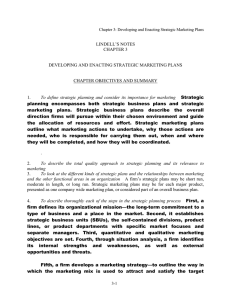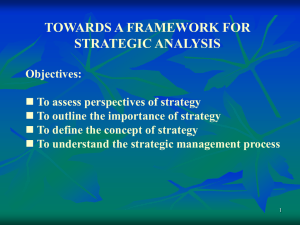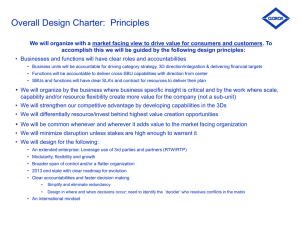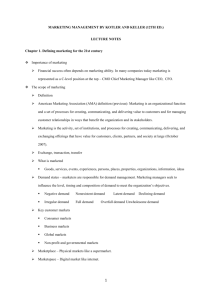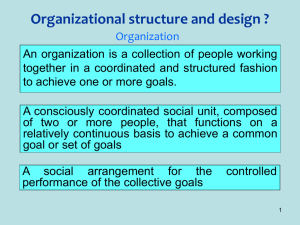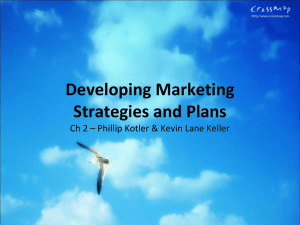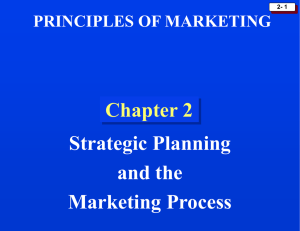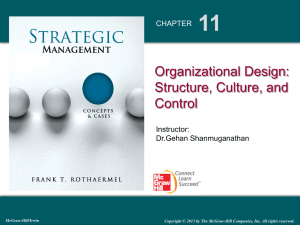BA 315 Chapter 2 Lec Sup BE
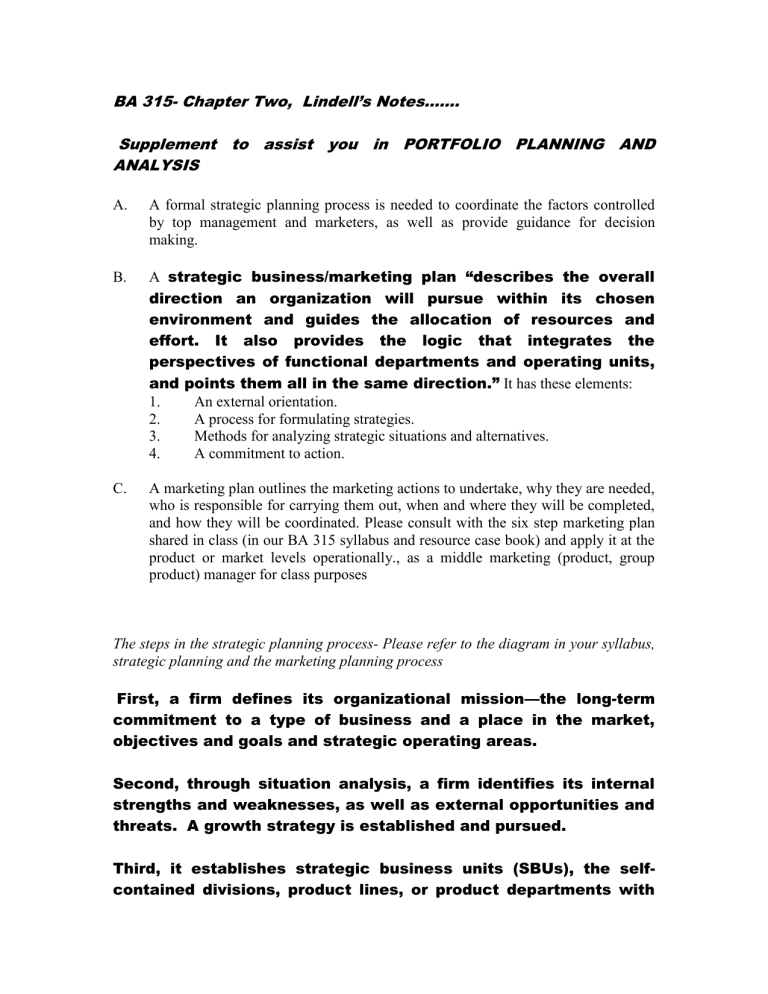
BA 315- Chapter Two, Lindell’s Notes…….
Supplement to assist you in PORTFOLIO PLANNING AND
ANALYSIS
A. A formal strategic planning process is needed to coordinate the factors controlled by top management and marketers, as well as provide guidance for decision making.
B. A strategic business/marketing plan “describes the overall direction an organization will pursue within its chosen environment and guides the allocation of resources and effort. It also provides the logic that integrates the perspectives of functional departments and operating units, and points them all in the same direction.”
It has these elements:
1. An external orientation.
2.
3.
4.
A process for formulating strategies.
Methods for analyzing strategic situations and alternatives.
A commitment to action.
C. A marketing plan outlines the marketing actions to undertake, why they are needed, who is responsible for carrying them out, when and where they will be completed, and how they will be coordinated. Please consult with the six step marketing plan shared in class (in our BA 315 syllabus and resource case book) and apply it at the product or market levels operationally., as a middle marketing (product, group product) manager for class purposes
The steps in the strategic planning process- Please refer to the diagram in your syllabus, strategic planning and the marketing planning process
First, a firm defines its organizational mission—the long-term commitment to a type of business and a place in the market, objectives and goals and strategic operating areas.
Second, through situation analysis, a firm identifies its internal strengths and weaknesses, as well as external opportunities and threats. A growth strategy is established and pursued.
Third, it establishes strategic business units (SBUs), the selfcontained divisions, product lines, or product departments with
specific market focuses and separate managers.
Fourth, quantitative and qualitative marketing objectives are set.
Fifth, a firm develops a marketing strategy—to outline the way in which the marketing mix is used to attract and satisfy the target
Sixth, the marketing managers spring into action and pursue their marketing plans for their responsibility areas to make their respective contributions.
DEFINING ORGANIZATIONAL MISSION
A. Organizational mission refers to a long-term commitment to a type of business and a place in the market.
1. It can be expressed in terms of the customer group(s) served, the goods and
2. services offered, the functions performed, and/or the technologies utilized.
It is considered implicitly when a company seeks a new customer group or abandons an existing one, introduces a new product category or deletes an old one, acquires another company or sells one of its own businesses, performs more (or fewer) marketing functions, or shifts its technological focus.
ESTABLISHING STRATEGIC BUSINESS UNITS
A.
A strategic business unit (SBU) is a self-contained division, product line, or product department in an organization with a specific market focus and a manager with complete responsibility for integrating all functions into a strategy.
B. Each SBU has these general attributes:
1. A specific target market.
2. Its own senior marketing executive.
3. Control over its resources.
4. Its own marketing strategy.
5. Clear-cut competitors.
6.
Distinctive differential advantages .
PORTFOLIO ANALYSIS (KEY PAGES SAY’S LPC)
The Product/Market Opportunity Matrix
A. The product/market opportunity matrix identifies four alternative marketing strategies to maintain and/or increase sales of business units and products: market penetration, market development, product development, and diversification.
1. In market penetration, a firm seeks to expand the sales of its present products in its present markets through more intensive distribution,
2. aggressive promotion, and competitive pricing.
In market development, a firm seeks greater sales of present products from new markets or new product uses. It can enter new markets, appeal to segments it is not yet satisfying, reposition products, and use new distribution methods.
3. In product development, a firm develops new or modified products to appeal to present markets. It emphasizes new models, better quality, and other minor innovations and markets them to loyal consumers.
4. In diversification, a firm becomes involved with new products aimed at new markets. The products may be new to the industry or to the company.
Distribution and promotion orientations are different from those traditionally used by the firm.
The Boston Consulting Group Matrix
A. The Boston Consulting Group matrix lets a firm classify each SBU in terms of market share relative to key competitors and annual industry growth.
B. With the matrix, it can be determined which SBUs are dominant and whether their industries are growing, stable, or declining.
C.
The matrix’s major assumption is that the higher an SBU’s market share, the lower its per-unit costs and the higher its profitability.
D. The Boston Consulting Group matrix identifies the four types of SBUs
1. A star
is a leading SBU in an expanding industry. The major goal is to
2. sustain differential advantages in the face of rising competition. It generates substantial profits but requires large amounts of resources to finance growth.
A cash cow
is a leading SBU in a mature or declining industry. It
3. generates funds that can be used for other SBUs.
A question mark (also called a wildcat or problem child) is an SBU that has had little impact (low market share) in an expanding industry (high growth). It needs substantial cash to improve its position.
4. A dog
is an SBU with limited sales (low market share) in a mature or declining industry (low growth). It has cost disadvantages and few growth opportunities.
The General Electric Business Screen
A. The General Electric business screen categorizes SBUs and products in terms of industry attractiveness and company business strengths
.
1. For each SBU or product opportunity, weights are assigned to industry and company attributes, individual attributes are rated, and industry
2.
3.
4. attractiveness and business strength ratings are derived. The SBU is then positioned on the business screen.
SBUs shown in green are investment/growth
areas. They are in strong industries and performing well. Full marketing resources are proper.
SBUs shown in yellow are selectivity/earnings
areas. These
SBUs may have strong positions in a weak industry (similar to a cash cow
), moderate positions in a somewhat attractive industry, or weak positions in an attractive industry (similar to a question mark
).
SBUs shown in red are harvest/divest areas and are similar to dog s in the Boston Consulting Group matrix.
The Porter Generic Strategy Model
A. The Porter generic strategy model identifies two key planning concepts and the alternatives available for each:
1.
Competitive scope
(broad or narrow target).
2.
Competitive advantage
(lower cost or differentiation).
B. The following three basic strategies are identified.
1.
Cost leadership —broad market and low cost position.
2.
Differentiation —large market and unique strategy.
3.
Focus —narrow target segment and either low cost position or a unique strategy.
Cost leadership and differentiation strategies are alternatives for large firms; a focus strategy is available to smaller firms.
Evaluation of Strategic Planning Approaches
A. Many firms assess alternative market opportunities; know which products are stars, cash cows, question marks, and dogs; recognize what factors affect performance; understand their industries; and realize they can target broad or narrow customer bases.
B. The major strengths
of the approaches are that they allow a firm to do the following:
1. Analyze each of its SBUs and products.
2.
3.
4.
Study various strategy effects.
Learn the opportunities to pursue and which threats to avoid.
Compute marketing and other resources needs.
5.
6.
Focus on meaningful differential advantages.
Compare performance with designated goals.
7.
8.
Discover principles for improving performance.
Study competitors’ actions and trends.
C. The approaches have these weaknesses
:
1.
2.
3.
They may be difficult to implement.
They may be too simplistic and omit key factors.
They are arbitrary in defining SBUs and evaluative criteria.
4.
5.
6.
7.
They may not be applicable to all firms and situations.
They may not adequately consider environmental factors.
They may overvalue market share.
They are often used by staff planners rather than line managers.
D.
These techniques only aid planning. They do not replace the need for managers to engage in hands-on decisions by studying each situation and basing marketing strategies on the unique aspects of their industry, firm, and SBUs.
A SAMPLE STRATEGIC PLAN………..
MOONSTRUCK CHOCOLATIER: A STRATEGIC MARKETING PLAN
BY A SMALL SPECIALTY FIRM
A.
Moonstruck Chocolatier was opened by Bill and Deb Simmons in Portland,
Oregon, in 1992 as a maker of truffles for the wholesale market. It sold to other retailers and opened its first retail store in 1996.
B.
The company currently has annual sales of $2 million and is successful due to its solid strategic marketing plan which is described.
Organizational Mission
A.
Moonstruck’s mission is to bring the higher European standard for chocolate to the
American marketplace and to create shops that serve as a meeting place in a busy, impersonal world.
1.
It is “romancing” the cocoa bean and educating the customer.
2. The company is about “a chocolate experience.”
Organizational Structure
A.
Bill and Deb Simmons manage the business.
B. Tony Roth purchased the exclusive rights to open Moonstruck stores in the
Midwest and his company acquired a 25 percent stake in Moonstruck Chocolatier.
Roth felt the need to take the superior product and menu direct to the market.
Marketing Objectives
A. These are the goals of Moonstruck:
1.
2.
3.
To grow from six stores in 2001 to 45 stores in Chicago, New York City, and Portland at year-end 2003.
To have annual sales of $26 million.
To become a brand as well known as Starbucks, substituting chocolate for coffee.
Situation Analysis
A. The Simmons’s strategic plan, as they freely admit, is based on that of Starbucks; they did a comprehensive analysis on Starbucks’ business model.
Developing Marketing Strategy
A.
The two strategic planning approaches with the most relevance for Moonstruck are the product/market opportunity matrix and the Porter generic strategy model.
1.
The firm is engaged in both a product development strategy (producing distinctive new chocolate products for current customers) and a market development strategy (seeking out those who have not thought of chocolate beverages as “must have” drinks).
2.
Moonstruck believes in a differentiation strategy (superior products at a premium price).
Societal, Ethical, and Consumer Issues
A. Moonstruck uses the highest-quality ingredients.
B. It treats employees and customers courteously, honesty, and respectfully.
C. The firm stands behind all of its products.
D. Moonstruck is socially responsible.
Global Marketing
A.
Moonstruck searches the globe for the best cocoa beans, consistent with its organizational mission.
Marketing and Internet
A.
Moonstruck uses its web site to get its message across to a larger audience by allowing online ordering.
Consumer Analysis and Target Market Strategy
A.
Moonstruck appeals to customers interested in quality, uniqueness, assortment, and service—and are willing to pay for it.
B.
These are the firm’s two market segments:
1.
Final consumers (who buy for personal use).
2.
Corporate customers (who buy as gifts and in larger quantities).
Product Planning
A.
Moonstruck has expanded, adding products that complement each other well.
Customers can buy truffles, coffee drinks, and chocolate drinks. The company mixes fresh, high-quality chocolate into exotic confections.
B. Chocolate in varying forms yields two-thirds of sales.
Distribution Planning
A.
Moonstruck’s retail stores are changing, due largely to Tony Roth’s influence.
They are larger, generate much greater sales, and have much higher profit margins.
Promotion Planning
A.
Moonstruck uses in-store tastings and demonstrations to draw customers into impulse purchases.
B.
It does some print advertising.
C.
The biggest promotion effort revolves around publicity from newspaper and magazine stories about Moonstruck products.
Price Planning
A.
Moonstruck has above-average prices.
1.
About 60 percent of revenues are from high-margin chocolate truffles and drinks.
Integrating and Analyzing the Plan
A.
Tony Roth is Moonstruck’s “management catalyst,” with a conviction to go forward. Roth visualizes the concept of Moonstruck in play.
Revising the Marketing Plan
A. Until late 1999, Moonstruck owned a bakery in Portland. It was sold to focus better on its chocolate business and the marketing strategy for it. The bakery had little synergy with the firm’s core business.
